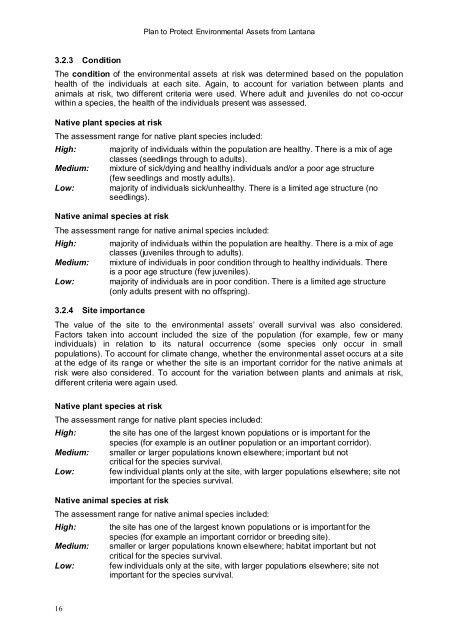Plan to Protect Environmental Assets from Lantana - Weeds Australia
Plan to Protect Environmental Assets from Lantana - Weeds Australia
Plan to Protect Environmental Assets from Lantana - Weeds Australia
You also want an ePaper? Increase the reach of your titles
YUMPU automatically turns print PDFs into web optimized ePapers that Google loves.
<strong>Plan</strong> <strong>to</strong> <strong>Protect</strong> <strong>Environmental</strong> <strong>Assets</strong> <strong>from</strong> <strong>Lantana</strong><br />
3.2.3 Condition<br />
The condition of the environmental assets at risk was determined based on the population<br />
health of the individuals at each site. Again, <strong>to</strong> account for variation between plants and<br />
animals at risk, two different criteria were used. Where adult and juveniles do not co-occur<br />
within a species, the health of the individuals present was assessed.<br />
Native plant species at risk<br />
The assessment range for native plant species included:<br />
High:<br />
Medium:<br />
Low:<br />
majority of individuals within the population are healthy. There is a mix of age<br />
classes (seedlings through <strong>to</strong> adults).<br />
mixture of sick/dying and healthy individuals and/or a poor age structure<br />
(few seedlings and mostly adults).<br />
majority of individuals sick/unhealthy. There is a limited age structure (no<br />
seedlings).<br />
Native animal species at risk<br />
The assessment range for native animal species included:<br />
High:<br />
Medium:<br />
Low:<br />
3.2.4 Site importance<br />
majority of individuals within the population are healthy. There is a mix of age<br />
classes (juveniles through <strong>to</strong> adults).<br />
mixture of individuals in poor condition through <strong>to</strong> healthy individuals. There<br />
is a poor age structure (few juveniles).<br />
majority of individuals are in poor condition. There is a limited age structure<br />
(only adults present with no offspring).<br />
The value of the site <strong>to</strong> the environmental assets’ overall survival was also considered.<br />
Fac<strong>to</strong>rs taken in<strong>to</strong> account included the size of the population (for example, few or many<br />
individuals) in relation <strong>to</strong> its natural occurrence (some species only occur in small<br />
populations). To account for climate change, whether the environmental asset occurs at a site<br />
at the edge of its range or whether the site is an important corridor for the native animals at<br />
risk were also considered. To account for the variation between plants and animals at risk,<br />
different criteria were again used.<br />
Native plant species at risk<br />
The assessment range for native plant species included:<br />
High:<br />
Medium:<br />
Low:<br />
the site has one of the largest known populations or is important for the<br />
species (for example is an outliner population or an important corridor).<br />
smaller or larger populations known elsewhere; important but not<br />
critical for the species survival.<br />
few individual plants only at the site, with larger populations elsewhere; site not<br />
important for the species survival.<br />
Native animal species at risk<br />
The assessment range for native animal species included:<br />
High:<br />
Medium:<br />
Low:<br />
the site has one of the largest known populations or is importantfor the<br />
species (for example an important corridor or breeding site).<br />
smaller or larger populations known elsewhere; habitat important but not<br />
critical for the species survival.<br />
few individuals only at the site, with larger populations elsewhere; site not<br />
important for the species survival.<br />
16

















